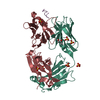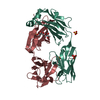+ Open data
Open data
- Basic information
Basic information
| Entry | Database: PDB / ID: 7sjm | ||||||
|---|---|---|---|---|---|---|---|
| Title | anti-HtrA1 Fab15H6.v4 | ||||||
 Components Components |
| ||||||
 Keywords Keywords | IMMUNE SYSTEM / Fab | ||||||
| Function / homology | Immunoglobulins / Immunoglobulin-like / Sandwich / Mainly Beta Function and homology information Function and homology information | ||||||
| Biological species |  Homo sapiens (human) Homo sapiens (human) | ||||||
| Method |  X-RAY DIFFRACTION / X-RAY DIFFRACTION /  SYNCHROTRON / SYNCHROTRON /  MOLECULAR REPLACEMENT / Resolution: 1.8 Å MOLECULAR REPLACEMENT / Resolution: 1.8 Å | ||||||
 Authors Authors | Ultsch, M.H. / Gerhardy, S. | ||||||
| Funding support | 1items
| ||||||
 Citation Citation |  Journal: Nat Commun / Year: 2022 Journal: Nat Commun / Year: 2022Title: Allosteric inhibition of HTRA1 activity by a conformational lock mechanism to treat age-related macular degeneration. Authors: Stefan Gerhardy / Mark Ultsch / Wanjian Tang / Evan Green / Jeffrey K Holden / Wei Li / Alberto Estevez / Chris Arthur / Irene Tom / Alexis Rohou / Daniel Kirchhofer /  Abstract: The trimeric serine protease HTRA1 is a genetic risk factor associated with geographic atrophy (GA), a currently untreatable form of age-related macular degeneration. Here, we describe the allosteric ...The trimeric serine protease HTRA1 is a genetic risk factor associated with geographic atrophy (GA), a currently untreatable form of age-related macular degeneration. Here, we describe the allosteric inhibition mechanism of HTRA1 by a clinical Fab fragment, currently being evaluated for GA treatment. Using cryo-EM, X-ray crystallography and biochemical assays we identify the exposed LoopA of HTRA1 as the sole Fab epitope, which is approximately 30 Å away from the active site. The cryo-EM structure of the HTRA1:Fab complex in combination with molecular dynamics simulations revealed that Fab binding to LoopA locks HTRA1 in a non-competent conformational state, incapable of supporting catalysis. Moreover, grafting the HTRA1-LoopA epitope onto HTRA2 and HTRA3 transferred the allosteric inhibition mechanism. This suggests a conserved conformational lock mechanism across the HTRA family and a critical role of LoopA for catalysis, which was supported by the reduced activity of HTRA1-3 upon LoopA deletion or perturbation. This study reveals the long-range inhibition mechanism of the clinical Fab and identifies an essential function of the exposed LoopA for activity of HTRA family proteases. | ||||||
| History |
|
- Structure visualization
Structure visualization
| Structure viewer | Molecule:  Molmil Molmil Jmol/JSmol Jmol/JSmol |
|---|
- Downloads & links
Downloads & links
- Download
Download
| PDBx/mmCIF format |  7sjm.cif.gz 7sjm.cif.gz | 187.5 KB | Display |  PDBx/mmCIF format PDBx/mmCIF format |
|---|---|---|---|---|
| PDB format |  pdb7sjm.ent.gz pdb7sjm.ent.gz | 147.7 KB | Display |  PDB format PDB format |
| PDBx/mmJSON format |  7sjm.json.gz 7sjm.json.gz | Tree view |  PDBx/mmJSON format PDBx/mmJSON format | |
| Others |  Other downloads Other downloads |
-Validation report
| Summary document |  7sjm_validation.pdf.gz 7sjm_validation.pdf.gz | 448.3 KB | Display |  wwPDB validaton report wwPDB validaton report |
|---|---|---|---|---|
| Full document |  7sjm_full_validation.pdf.gz 7sjm_full_validation.pdf.gz | 449.4 KB | Display | |
| Data in XML |  7sjm_validation.xml.gz 7sjm_validation.xml.gz | 22.3 KB | Display | |
| Data in CIF |  7sjm_validation.cif.gz 7sjm_validation.cif.gz | 34 KB | Display | |
| Arichive directory |  https://data.pdbj.org/pub/pdb/validation_reports/sj/7sjm https://data.pdbj.org/pub/pdb/validation_reports/sj/7sjm ftp://data.pdbj.org/pub/pdb/validation_reports/sj/7sjm ftp://data.pdbj.org/pub/pdb/validation_reports/sj/7sjm | HTTPS FTP |
-Related structure data
| Related structure data |  7sjnC  7sjoC  7sjpC  1fvdS S: Starting model for refinement C: citing same article ( |
|---|---|
| Similar structure data | Similarity search - Function & homology  F&H Search F&H Search |
- Links
Links
- Assembly
Assembly
| Deposited unit | 
| ||||||||
|---|---|---|---|---|---|---|---|---|---|
| 1 |
| ||||||||
| Unit cell |
|
- Components
Components
| #1: Antibody | Mass: 24232.924 Da / Num. of mol.: 1 Source method: isolated from a genetically manipulated source Source: (gene. exp.)  Homo sapiens (human) / Production host: Homo sapiens (human) / Production host:  | ||||||||
|---|---|---|---|---|---|---|---|---|---|
| #2: Antibody | Mass: 23181.654 Da / Num. of mol.: 1 Source method: isolated from a genetically manipulated source Source: (gene. exp.)  Homo sapiens (human) / Production host: Homo sapiens (human) / Production host:  | ||||||||
| #3: Chemical | ChemComp-SO4 / #4: Chemical | #5: Water | ChemComp-HOH / | Has ligand of interest | N | Has protein modification | Y | |
-Experimental details
-Experiment
| Experiment | Method:  X-RAY DIFFRACTION / Number of used crystals: 1 X-RAY DIFFRACTION / Number of used crystals: 1 |
|---|
- Sample preparation
Sample preparation
| Crystal | Density Matthews: 2.6 Å3/Da / Density % sol: 52.68 % |
|---|---|
| Crystal grow | Temperature: 291 K / Method: vapor diffusion, sitting drop / pH: 5.1 Details: 2.1M ammonium sulfate, 0.1M Tri-sodium citrate pH 5.1 PH range: 5.0-6.0 |
-Data collection
| Diffraction | Mean temperature: 93 K / Serial crystal experiment: N |
|---|---|
| Diffraction source | Source:  SYNCHROTRON / Site: SYNCHROTRON / Site:  SSRL SSRL  / Beamline: BL12-2 / Wavelength: 0.98 Å / Beamline: BL12-2 / Wavelength: 0.98 Å |
| Detector | Type: DECTRIS PILATUS 6M / Detector: PIXEL / Date: Jan 10, 2018 / Details: Liquid nitrogen-cooled double crystal Si(111) |
| Radiation | Protocol: SINGLE WAVELENGTH / Monochromatic (M) / Laue (L): M / Scattering type: x-ray |
| Radiation wavelength | Wavelength: 0.98 Å / Relative weight: 1 |
| Reflection | Resolution: 1.8→39.47 Å / Num. obs: 44014 / % possible obs: 97.27 % / Redundancy: 2 % / CC1/2: 0.998 / Rmerge(I) obs: 0.047 / Rpim(I) all: 0.07 / Rrim(I) all: 0.101 / Net I/σ(I): 11.2 |
| Reflection shell | Resolution: 1.8→1.83 Å / Redundancy: 1.9 % / Rmerge(I) obs: 0.4061 / Mean I/σ(I) obs: 2.09 / Num. unique obs: 4284 / CC1/2: 0.674 / Rpim(I) all: 0.639 / Rrim(I) all: 0.919 / % possible all: 95.37 |
- Processing
Processing
| Software |
| ||||||||||||||||||||||||||||||||||||||||||||||||||||||||||||||||||||||||||||||||||||||||||||||||||||||||||||
|---|---|---|---|---|---|---|---|---|---|---|---|---|---|---|---|---|---|---|---|---|---|---|---|---|---|---|---|---|---|---|---|---|---|---|---|---|---|---|---|---|---|---|---|---|---|---|---|---|---|---|---|---|---|---|---|---|---|---|---|---|---|---|---|---|---|---|---|---|---|---|---|---|---|---|---|---|---|---|---|---|---|---|---|---|---|---|---|---|---|---|---|---|---|---|---|---|---|---|---|---|---|---|---|---|---|---|---|---|---|
| Refinement | Method to determine structure:  MOLECULAR REPLACEMENT MOLECULAR REPLACEMENTStarting model: 1FVD Resolution: 1.8→39.47 Å / Cor.coef. Fo:Fc: 0.956 / Cor.coef. Fo:Fc free: 0.9425 / SU R Cruickshank DPI: 0.114 / Cross valid method: THROUGHOUT / σ(F): 0 / SU R Blow DPI: 0.12 / SU Rfree Blow DPI: 0.111 / SU Rfree Cruickshank DPI: 0.108
| ||||||||||||||||||||||||||||||||||||||||||||||||||||||||||||||||||||||||||||||||||||||||||||||||||||||||||||
| Displacement parameters | Biso max: 113.44 Å2 / Biso mean: 27.38 Å2 / Biso min: 10.15 Å2
| ||||||||||||||||||||||||||||||||||||||||||||||||||||||||||||||||||||||||||||||||||||||||||||||||||||||||||||
| Refine analyze | Luzzati coordinate error obs: 0.196 Å | ||||||||||||||||||||||||||||||||||||||||||||||||||||||||||||||||||||||||||||||||||||||||||||||||||||||||||||
| Refinement step | Cycle: final / Resolution: 1.8→39.47 Å
| ||||||||||||||||||||||||||||||||||||||||||||||||||||||||||||||||||||||||||||||||||||||||||||||||||||||||||||
| Refine LS restraints |
| ||||||||||||||||||||||||||||||||||||||||||||||||||||||||||||||||||||||||||||||||||||||||||||||||||||||||||||
| LS refinement shell | Resolution: 1.8→1.85 Å / Rfactor Rfree error: 0 / Total num. of bins used: 20
| ||||||||||||||||||||||||||||||||||||||||||||||||||||||||||||||||||||||||||||||||||||||||||||||||||||||||||||
| Refinement TLS params. | Method: refined / Refine-ID: X-RAY DIFFRACTION
| ||||||||||||||||||||||||||||||||||||||||||||||||||||||||||||||||||||||||||||||||||||||||||||||||||||||||||||
| Refinement TLS group |
|
 Movie
Movie Controller
Controller





 PDBj
PDBj






